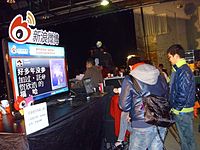
Photo from wikipedia
ABSTRACT Research has considered how exposure to prosocial television narratives influences children’s social inclusion behaviors (e.g., Mares & Acosta, 2010). In these experiments, children typically view a stimulus episode alone;… Click to show full abstract
ABSTRACT Research has considered how exposure to prosocial television narratives influences children’s social inclusion behaviors (e.g., Mares & Acosta, 2010). In these experiments, children typically view a stimulus episode alone; however, we know that children often watch with others at home (Chandler, 1997). Thus, in this study we examined how children’s proximal social context during viewing influenced effects. Using data collected from a 3-condition experiment (control, view-alone, coview with close friend) with Dutch children ages 5 and 6 (N = 80), we found that exposure largely did not influence children’s inclusion judgments or stigmatization beliefs. There was, however, an age × condition interaction, such that 6-year-old children in the coview condition demonstrated greater stigmatization beliefs toward other children, compared to 5-year-olds in the same condition, or all children in the other conditions. We discuss the implications of these findings while considering previous work on learning inclusion from prosocial television shows, reality judgments, and the bystander effect.
Journal Title: Media Psychology
Year Published: 2019
Link to full text (if available)
Share on Social Media: Sign Up to like & get
recommendations!